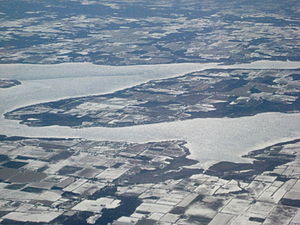Lake Scugog
| Lake Scugog | ||
|---|---|---|
Primary inflows Nonquon River, Blackstock Creek, Cawkers Creek | | |
| Primary outflows | Scugog River | |
| Catchment area | 529 square kilometres (204 sq mi) | |
| Basin countries | Canada | |
| Surface area | 68 square kilometres (26 sq mi) | |
| Average depth | 1.4 metres (4 ft 7 in) | |
| Max. depth | 7.6 metres (24 ft 11 in) | |
| Water volume | 0.0957 cubic kilometres (0.0230 cu mi) | |
| Shore length1 | 172 kilometres (107 mi) | |
| Surface elevation | 249.9 metres (819 ft 11 in) | |
| Islands | Scugog Island | |
| Settlements | Port Perry, Lindsay | |
| 1 Shore length is not a well-defined measure. | ||
Lake Scugog is an
Etymology
The name "Scugog" may be an Ojibwe word meaning "marshy waters". However, according to Place Names of Ontario by Alan Rayburn, Scugog is a Mississauga word meaning 'waves leap over a canoe' in reference, perhaps, to the flooding of the river valley, or, more likely, the quickness that waves can be whipped up in winds, owing to its shallowness.[2]
Geography

With 68 km² with an average depth of 1.4 metres, Lake Scugog is amongst the largest five lakes of the Kawarthas by
A 2.58 km2 (1.00 sq mi) Mississaugian Indian Reserve of about 50 residents exists on Scugog Island,[4] and includes the Great Blue Heron Casino, amongst the many seasonal cottagers on the island and around the lake.
Hydrology
It is a hard-water marl-producing lake, and the lake bottom consists of deep deposits of it. This gives the lake a murky appearance in warm weather, especially during the summer. The lake is reportedly filling in with this marl by about 1 millimetre per year.[citation needed]
In dry summer weather, the Scugog River ceases to flow out of the lake, and its tributary streams of Mariposa Brook and East Cross Creek flow backward into the lake via the river to offset the high evaporative losses off the lake and marsh surfaces.
History
The lake has had a history of water level changes. Originally, it was essentially two lakes connected via a broad channel flowing through a
The stagnant waters of the lake caused a wave of deadly fevers in the surrounding farms, and the new lake limits quickly became very unpopular with the local residents. On one day in the summer of 1838, settlers from the countryside surrounding the lake rose up and using axes, flintlocks and pitchforks, tore the dam apart, lowering the lake once more.
Natural history
The original body of water consisted of the upper sections of the current lake and was more ideally a shallow marsh than an actual lake.[8]
The marshes of the lake prior to flooding were filled with wild rice stands and cranberries harvested by the native Mississaugas. The flooding of the lakes contributed greatly to their destruction.
It is surrounded by swamps and marshes which provide ideal habitat for waterfowl and other wildlife.
Lake Scugog has an array of fish, including an abundant supply of largemouth bass, walleye, crappie, musky, perch, carp, catfish, rock bass, smallmouth bass and minnows. Due to a dwindling walleye population, there is no season to catch or keep walleye. It is a renowned fishing location in southern Ontario.[9]
Economy


Like many of the lakes of southern Ontario, Scugog served for a time as a vessel for transporting logs downstream to
Today, the lake is a tourist area, forming the southern boundary to "Cottage Country". The towns of Port Perry and Lindsay benefit from the recreational boating through the Trent-Severn Waterway by vacationers in the summer. Fishing is also a major attraction of the lake, as its shallow weed-filled bed is host to an abundance of species.
Watershed
A list of rivers feeding to and from the lake:
- Nonquon River - flows from the southwest (near Utica) towards Seagrave. The river empties into Lake Scugog southeast of Seagrave.
- Cawkers Creek - flow from southwest end of Port Perry southwards for 16 km
- Mariposa Brook - also known as Big Creek, Black Creek, Davidson's Creek, and West Cross Creek begins in swamps near Manilla then flows northeast to then south past Little Britain and then east to empty into the Scugog River at Ops
- Blackstock Creek - found southeast of Lake Scugog between the Lake Scugog and East Cross Creek
- Scugog River
Osler Marsh
The marsh on the lake along the Port Perry Causeway south of
See also
- List of lakes in Ontario
References
- ^ a b "Lake Scugog". Geographical Names Data Base. Natural Resources Canada. Retrieved 2015-02-09.
- ^ Alan Rayburn. Place Names of Ontario. University of Toronto Press, 1997 - History - 404 p.
- ^ "Trent Watershed Study (topography and drainage map)" (PDF). Retrieved 2009-07-30.
- ^ "Statistics Canada 2001 Census Community Profiles, Mississaugas of Scugog Island". 2001. Retrieved 2009-07-30.[permanent dead link]
- ^ Kirkconnell, Watson (1967), County of Victoria, Centennial History, Victoria County Council, p. 30, retrieved 2009-07-30
- ^ Kirkconnell, Watson (1967), County of Victoria, Centennial History, Victoria County Council, p. 31, retrieved 2009-07-30
- ^ Kirkconnell, Watson (1967), County of Victoria, Centennial History, Victoria County Council, p. 32, retrieved 2009-07-30
- ^ "Port Perry / Scugog TWP. Heritage Gallery".
- ^ "The Fishing Guide - Lake Scugog". Retrieved 2009-07-30.
- ^ Kirkconnell, Watson (1967), County of Victoria, Centennial History, Victoria County Council, pp. 30–33, retrieved 2009-07-30
- ^ "The Scugog Marshland". Port Perry / Scugog Township Heritage Gallery. Retrieved 24 November 2018.
- ^ "Lake Scugog Subwatershed". Kawartha Conservation. Retrieved 24 November 2018.

